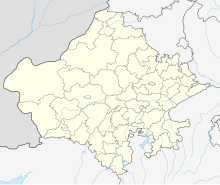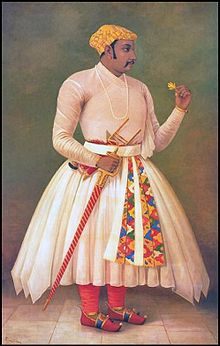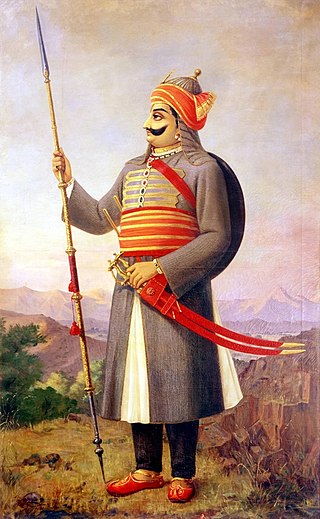
Pratap Singh I, popularly known as Maharana Pratap, was a king of Kingdom of Mewar, in north-western India in the present-day state of Rajasthan. He is notable for leading the Rajput resistance against the expansionist policy of the Mughal Emperor Akbar including the Battle of Haldighati.

The Sisodia was an Indian royal dynasty belonging to the clan that ruled over the Kingdom of Mewar, in the region of Mewar in Rajasthan. The name of the clan is also transliterated as Sesodia, Shishodia, Sishodia, Shishodya, Sisodya, Sisodiya, Sisodia.
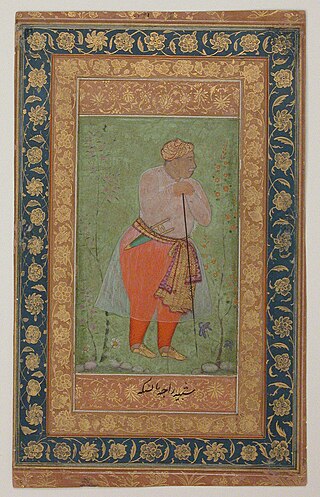
Mirza RajaMan Singh I was the 24th Maharaja of Kingdom of Amber from 1589 to 1614. He also served as the Subahdar of Bengal for three terms from 1595 to 1606 and the Subahdar of Kabul from 1585 to 1586. He served in the Mughal Army under Emperor Akbar. Man Singh fought sixty-seven important battles in Kabul, Balkh, Bukhara, Bengal and Central and Southern India. He was well versed in the battle tactics of both the Rajputs as well as the Mughals. He is commonly considered to be one of the Navaratnas, or the nine (nava) gems (ratna) of the royal court of Akbar.

The battle of Haldighati was fought on 18 June 1576 between the Mewar forces led by Maharana Pratap, and the Mughal forces led by Man Singh I of Amber. The Mughals emerged victorious after inflicting significant casualties on Mewari forces, though they failed to capture Pratap, who reluctantly retreated persuaded by his fellow commanders.

The Kingdom of Amber, also known as Kingdom of Dhundhar, and Jaipur State, was located in the north-eastern historic Dhundhar region of Rajputana and was ruled by the Kachwaha Rajput clan. It was established by Dulha Rai, possibly the last ruler of the Kachchhapaghata dynasty of Gwalior who migrated to Dausa and started his kingdom there with the support of Chahamanas of Shakambhari in the 12th century. Mostly through 12th to 15th century, the kingdom faced stagnation, sources were scarce. Under its ruler, Raja Chandrasen of Amber became a Sisodia vassal and fought in the Battle of Khanwa under Raja Prithviraj Kachhwaha.
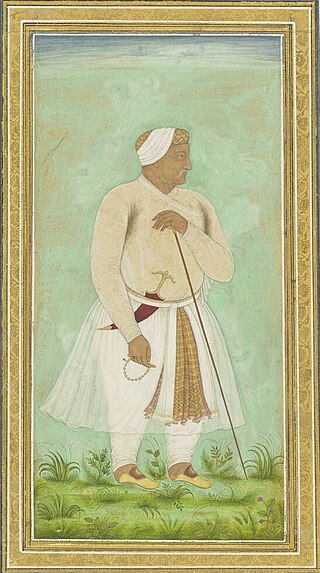
Raja Bhagwant Das was the 23rd Kacchwaha ruler of Amber.He also served as the Subahdar of Lahore and the Subahdar of Kabul for a few months in 1586. His sister, Mariam-uz-Zamani, was the chief consort of Mughal emperor Akbar. His son, Man Singh I, one of the Navaratnas of Akbar became the highest-ranking official of his court and his daughter, Man Bai, was the first and chief wife of Prince Salim.

Udai Singh II was the 12th Maharana of the Kingdom of Mewar and the founder of the city of Udaipur in the present-day state of Rajasthan, India. He was the fourth son of Rana Sanga and Rani Karnavati, a princess of Bundi.

The Kingdom of Mewar was an independent kingdom that existed in the Rajputana region of the Indian subcontinent and later became a major power in medieval India. The kingdom was initially founded and ruled by the Guhila dynasty followed by the Sisodiya Dynasty. The earliest kingdom was centered around the south-central part of Rajasthan, state of India. It was bordered by the Aravali Range to the northwest, Ajmer to the north, Gujarat, Vagad and Malwa regions to the south and the Hadoti region to the east.

Kingdom of Marwar, also known as the Jodhpur State under the British, was a kingdom in the Marwar region from 1243 to 1818 and a princely state under British rule from 1818 to 1947. It was established in Pali by Rao Siha, possibly a migrant Gahadavala noble, in 1243. His successors continued to struggle against regional powers for domination and 9 out of 15 rulers till 1438 died in combat. In 1395, its capital was changed to Mandore by Rao Chunda of Mandore and to Jodhpur in 1459 by Rao Jodha.
The Mughal–Rajput wars were a series of battles between the Rajput Confederacy and the Mughal Empire. The conflicts originated with the invasion of northwestern India by the Mughal ruler Babur, to which the head of the Rajput confederacy, Rana Sanga, offered staunch resistance. The conflicts went on since 1526 for over 200 years, with the Mughals having the upper hand until the death of Aurangzeb in 1707, following which they entered a declining phase and the Rajputs gained the upper hand, with the last recorded conflict taking place in 1779.

Maharana Pratap: The First Freedom Fighter is an Indian epic film based on Maharana Pratap of Mewar .The film is directed and produced by Dr. Pradeep Kumawat from Udaipur, Rajasthan. It is the first time that a film has been made on the history of Maharana Pratap. The film's sound track includes one of the last songs sung by Late Jagjit Singh.

Bharat Ka Veer Putra – Maharana Pratap is an Indian historical fiction series produced by Contiloe Entertainment. It is based on the life of Maharana Pratap, a sixteenth century ruler of Mewar kingdom. It starred Sharad Malhotra, Rachana Parulkar, Faisal Khan and Roshni Walia.

Maharana Amar Singh I, the Maharana ruler of Mewar Kingdom, was the eldest son and successor of Maharana Pratap I. He was the 14th Rana of Mewar, ruling from January 19, 1597 till his death on January 26, 1620.

Maharana Raj Singh I, was the Maharana of Mewar Kingdom and eldest son of Maharana Jagat Singh I. He fought against Mughal Empire and annexed many Mughal territories He participated in Rajput-Mughal War (1679–1707) and defeated the Mughals.
The history of human settlement in the west Indian state of Rajasthan dates back to about 5,000 years ago.
Political marriages in India have occurred throughout the history.
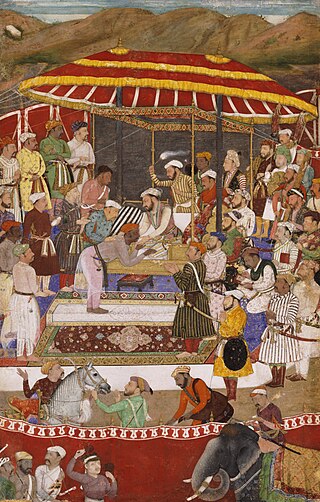
The Mughal conquest of Mewar was a military campaign led by Shah Jahan under the command of Emperor Jahangir in 1615. After a year of attrition warfare, Rana Amar Singh I surrendered conditionally to the Mughal forces, transforming Mewar into a vassal state of the Mughal Empire.

Shahbaz Khan's invasions of Mewar were expeditions into Mewar by the Mughal forces of Shahbaz Khan Kamboh. The expansion of the Mughal Empire was initiated during the reign of Akbar the Great. This was notably evident in the Battle of Haldighati, where the Mewar forces suffered a futile defeat, compelling Rana Pratap to retreat to the hills. In the aftermath, multiple expeditions were dispatched to Mewar under the leadership of Shahbaz Khan Kamboh, ultimately leading to the permanent pacification of important territories like Mandalgarh, Kumbhalgarh, Gogunda, and Chittorgarh. These successful conquests culminated in the assimilation of Mewar into the Mughal Empire in 1616.
